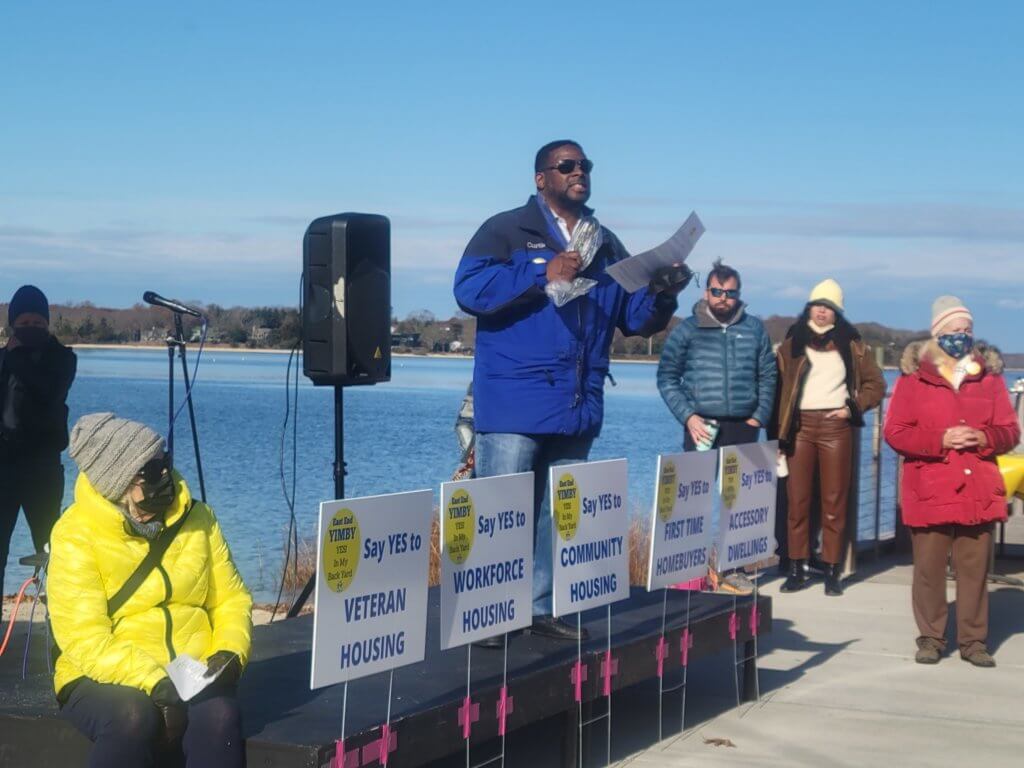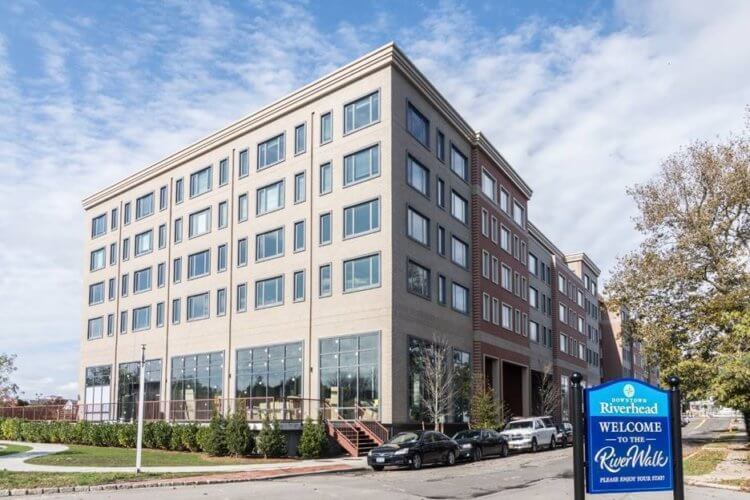Seeking Shelter: East End YIMBY Rallies Against Affordable Housing Opponents

Longtime local residents priced out of their East End homes. Immigrants fearing job loss for exposing exploitative landlords. College graduates who go down the Brain Drain — the trend of young college graduates moving away instead of becoming their community’s workforce.
The people impacted by the housing crunch squeezing folks from the Hamptons and North Fork spans age, race and income, but advocates say the trend has reached critical mass after the coronavirus pandemic caused real estate prices to skyrocket over the past two years as housing demand outpaced supply. Rallying in support of more affordable housing being built in the Twin Forks area to help ease the crisis, advocates took to the streets — or Long Wharf in Sag Harbor, as it were.
“Fight, fight, fight, housing is a right,” ralliers chanted on December 4 at the village waterfront during an East End YIMBY, which stands for Yes In My Backyard — the opposite of the NIMBY crowd who say “no” to developments in their communities. “What do we want? Housing! When do we want it? Now!”
The issue is so pronounced that New York State recently enacted the Peconic Bay Region Community Housing Fund Act that will give the five East End towns the ability to raise money for affordable housing in a similar way to how money is raised for the successful Community Preservation Fund, through a real estate transfer tax, once the towns pass local legislation advancing the measure. The trend of wealthy New York City residents fleeing to the East End to avoid the pandemic fueled the price surge, and punctuated the need for the law after the prior administration vetoed an earlier attempt at passage.

“I think as long as I’ve been involved in government and politics on the East End, affordable housing has been a major issue, and the pandemic only exacerbated it and brought it to crisis proportions,” New York State Assemblyman Fried W. Thiele Jr. (I-Sag Harbor), who authored the legislation, told Behind The Hedges.
The community itself is at stake, advocates warn.
“The ability to sustain a resort community without local workers is not possible,” said Ellen Dioguardi, the recording secretary of the Sag Harbor Chamber of Commerce. “The ability to sustain the kind of community that many of us cherish here without teachers and police officers and office workers and restaurant workers and retail staff able to live and work within that community is not possible.”
As Dan’s Papers has reported, local employers have expressed concerns that the housing crunch is contributing to the staffing shortages impacting the hospitality industry since the area’s real estate prices have outpaced the pay rates for such jobs. And some of those who have stayed are hanging on by a thread, advocates say.
Minerva Perez, executive director of OLA of Eastern Long Island (Organización Latino-Americana), a group that advocates for the Hispanic immigrant community in the region, says residents paying exorbitant rent to live in squalor is commonplace in the shadows of the Hamptons McMansions commanding record sales prices in recent years.
“Nearly all of the clients and community members that we are working with right now are suffering through and trying to navigate … some degree of housing exploitation,” she told the crowd at the rally. “And I don’t use (the word) ‘exploitation’ loosely. I say it as the result of threats that people are experiencing, astronomical rent hikes without any kind of notice, the denial of fixing things that are really egregiously wrong, like heating that’s broken, like roofing that’s caving in.
“People are living in these squalid conditions because there is no other place to go,” she continued. “And they’re saying, ‘Don’t tell anyone that the (roof) is caving in, I need to keep my kids in the school district. I need to keep my job. I’ll get a tarp. I’ll make it work. And I’ll pay $3,500 a month.”
Some of the pushback on proposed affordable housing projects comes from the perception that it will increase crime in the community. But the stereotype doesn’t match reality, proponents say. David Gallo, CEO of Jericho-based affordable housing developer Georgica Green Ventures, LLC, pointed to some of his projects, which include the recently opened 116-unit Riverview Lofts in downtown Riverhead, Sandy Hollow Cove Apartments and Speonk Commons, a 66-unit scattered site development, with 28 units in Southampton and 38 transit-oriented units in Speonk.
“I often say, ‘It’s not your grandfather’s affordable housing,’” Gallo told the crowd. “We work really hard on the quality.”
Such developments have a positive qualitative impact as well, he added.
“Diversity of race, diversity of income, diversity of age makes our community better and our children smarter,” he said.
What happens when those kids grow up remains a challenge. The Brain Drain trend siphoning off the region’s young professionals that would be next to work and raise families in the community has been an issue for long before the pandemic. But it’s not getting any better.
“Our kids are going away … getting degrees and they can’t come home,” said Bonnie Cannon, executive director at Bridgehampton Child Care & Recreational Center and chair of the Southampton Housing Authority. “Our families are being disbursed. The kids want to come home but they have no place to live. We have to do better, we have to come together, we have to continue to fight, not only here, but everywhere on eastern Long Island.”
-With additional reporting by David Taylor and Taylor K. Vecsey



